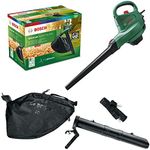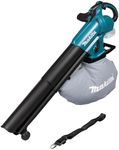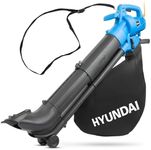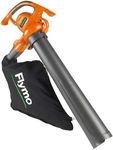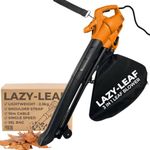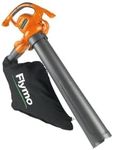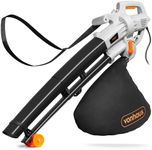Buying Guide for the Best Leaf Vacuums
Choosing the right leaf vacuum can make yard work much easier and more efficient. When selecting a leaf vacuum, it's important to consider various specifications to ensure you get a model that fits your needs. Understanding these key specs will help you make an informed decision and find the best leaf vacuum for your specific requirements.Power SourceLeaf vacuums can be powered by electricity (corded or cordless) or gasoline. Electric models are generally quieter, lighter, and require less maintenance, making them suitable for smaller yards and lighter tasks. Cordless models offer more mobility but have limited battery life. Gasoline-powered vacuums are more powerful and can handle larger areas and tougher jobs, but they are heavier, noisier, and require more maintenance. Choose based on the size of your yard and the intensity of the work you need to perform.
Airflow (CFM)CFM stands for Cubic Feet per Minute and measures the volume of air the vacuum can move. Higher CFM means the vacuum can move more leaves and debris at once. For small yards with light leaf coverage, a lower CFM (around 200-300) may be sufficient. For larger yards or areas with heavy leaf fall, look for a higher CFM (400 and above) to ensure efficient cleaning. Consider the amount of leaves and debris you typically deal with to determine the right CFM for your needs.
Mulching RatioThe mulching ratio indicates how finely the vacuum can shred leaves and debris. A higher ratio means the leaves are shredded into smaller pieces, which can reduce the volume of waste and make it easier to compost or dispose of. Common ratios range from 10:1 to 16:1. If you plan to use the shredded material for composting or have limited space for waste, a higher mulching ratio is beneficial. For general yard cleanup, a standard ratio will suffice.
Bag CapacityBag capacity refers to the amount of debris the vacuum can hold before needing to be emptied. Larger capacities mean fewer trips to empty the bag, which can save time and effort. Smaller bags (up to 10 gallons) are suitable for small yards and light tasks, while larger bags (10-20 gallons or more) are better for bigger yards and heavy-duty work. Consider the size of your yard and the volume of leaves you typically collect to choose the appropriate bag capacity.
WeightThe weight of the leaf vacuum affects how easy it is to maneuver and use for extended periods. Lighter models (under 10 pounds) are easier to handle and suitable for smaller tasks, while heavier models (over 10 pounds) may offer more power but can be tiring to use for long periods. If you have a large yard or need to use the vacuum for extended periods, consider a model with a comfortable weight and ergonomic design to reduce fatigue.
Noise LevelNoise level is an important consideration, especially if you live in a neighborhood with noise restrictions or prefer a quieter operation. Electric models are generally quieter than gas-powered ones. Noise levels are measured in decibels (dB), with lower numbers indicating quieter operation. If noise is a concern, look for models with noise levels under 70 dB. For those who prioritize power over noise, be prepared for higher noise levels, especially with gas-powered models.
